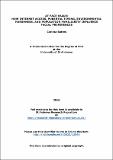Files in this item
At face value : how internet access, pubertal timing, environmental harshness, and population familiarity influence facial preferences
Item metadata
| dc.contributor.advisor | Perrett, David | |
| dc.contributor.author | Batres, Julia Carlota | |
| dc.coverage.spatial | 142 | en_US |
| dc.date.accessioned | 2018-03-05T12:42:02Z | |
| dc.date.available | 2018-03-05T12:42:02Z | |
| dc.date.issued | 2016-04-12 | |
| dc.identifier.uri | https://hdl.handle.net/10023/12849 | |
| dc.description.abstract | Chapter One introduces the field of evolutionary psychology as well as provides a review of factors influencing facial attractiveness. Chapter Two presents empirical evidence that online studies may provide a distorted perspective on cross-cultural face preferences since online samples are not representative of the populations in developing countries. In El Salvador, participants without internet access preferred more feminine men as well as heavier and more masculine women when compared to participants with internet access. One possible explanation for such findings is that the level of harshness in the environment may be influencing preferences. One individual difference that is influenced by environmental harshness is age of menarche. Chapter Three thus provides exploratory evidence that age of menarche also influences masculinity preferences. Chapter Four further examines this environmental harshness hypothesis by repeatedly testing students undergoing intensive training at an army camp. Increases in the harshness of the environment led to an increased male attraction to cues of higher weight in female faces. Such changes in preferences may be adaptive because they allow for more opportunities to form partnerships with individuals who are better equipped to survive. An alternative explanation for the empirical findings in Chapters Two and Four is that familiarity may also influence preferences. Chapter Five tests this familiarity hypothesis by examining the faces of participants in different areas of El Salvador and Malaysia. Rural participants preferred heavier female faces than urban participants. Additionally, the faces of female participants from rural areas were rated as looking heavier. This finding suggests that familiarity may indeed influence attractiveness perceptions. Lastly, Chapter Six draws conclusions from the empirical findings reported in Chapters Two-Five and lists proposals of future research that could further enhance our understanding of what we find attractive. | en_US |
| dc.language.iso | en | en_US |
| dc.publisher | University of St Andrews | |
| dc.subject | Faces | en_US |
| dc.subject | Preferences | en_US |
| dc.subject | Adiposity | en_US |
| dc.subject | Masculinity | en_US |
| dc.subject | Attraction | en_US |
| dc.subject.lcc | BF859.B2 | |
| dc.subject.lcsh | Adolescence | en |
| dc.subject.lcsh | Internet users | en |
| dc.subject.lcsh | Face perception | en |
| dc.title | At face value : how internet access, pubertal timing, environmental harshness, and population familiarity influence facial preferences | en_US |
| dc.type | Thesis | en_US |
| dc.type.qualificationlevel | Doctoral | en_US |
| dc.type.qualificationname | PhD Doctor of Philosophy | en_US |
| dc.publisher.institution | The University of St Andrews | en_US |
This item appears in the following Collection(s)
Items in the St Andrews Research Repository are protected by copyright, with all rights reserved, unless otherwise indicated.

